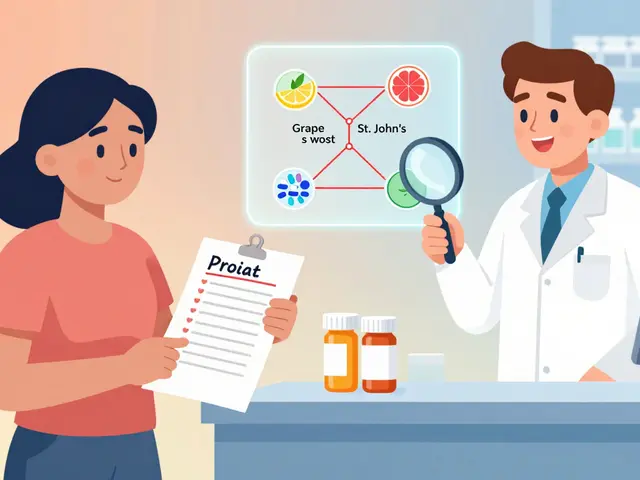In today's demanding work environment, the ability to maintain focus and manage tasks efficiently is crucial for career advancement. With attention spans seemingly dwindling, and workplace distractions ever-present, finding ways to enhance concentration is more relevant than ever. Atomoxetine, a trusted medication for ADHD, is gaining recognition for more than just its therapeutic effects in clinical settings.
Professionals who have tapped into the benefits of atomoxetine report significant gains not only in their productivity but also in their capacity to achieve their career aspirations. By understanding how this medication works to improve focus and reduce impulsive behavior, individuals can harness these improvements to negotiate the complexities of their work-life balance. As with any medication, it's essential to consider personal circumstances and potential side effects, making an informed decision critical. The following sections explore how atomoxetine can be a powerful companion in your professional journey, if used wisely.
- Atomoxetine and Its Role
- The Mechanism Behind Increased Productivity
- Real-Life Benefits for Professionals
- Challenges and Considerations
- Maximizing Atomoxetine's Potential in Your Career
Atomoxetine and Its Role
Atomoxetine, commonly known by its brand name Strattera, is primarily prescribed to treat Attention Deficit Hyperactivity Disorder (ADHD). Unlike the typical stimulant medications that are often associated with treating ADHD, atomoxetine is a non-stimulant. It works as a selective norepinephrine reuptake inhibitor (NRI), which increases the availability of norepinephrine, a neurotransmitter involved in attention and impulse control, across synaptic clefts in the brain. By enhancing this chemical messenger, atomoxetine helps individuals gain a better command over their focus and behavior, bringing about a more centered and deliberate approach to tasks. This unique mechanism means that atomoxetine does not carry the risk of abuse and dependency often linked with stimulant medications, a factor that many find reassuring. For those balancing busy personal and professional lives, the reduced side effect profile of atomoxetine can make it an appealing choice.
It's interesting to consider how atomoxetine has carved out a niche beyond its traditional role in clinical settings. Its efficacy in aiding focus is translating well into the workplace, where attention to detail and task completion is paramount. Amidst this increasing interest, studies have shown that individuals have experienced significant improvements in task management and organization after the introduction of atomoxetine to their routine. Users report a distinct shift in their attention span and the ability to engage with tasks for prolonged periods without succumbing to distractions. For those in demanding professions, this has proven to be a game-changer.
Despite its growing popularity and benefits, atomoxetine is not without its potential pitfalls. Users might encounter side effects, which can range from mild to more significant, though they are often transient as the body adjusts to the medication. Symptoms such as stomach upset, dry mouth, and appetite changes are reported, yet many find them manageable. Moreover, there have been ongoing discussions about its effects on mental health, particularly concerning its influence on mood swings and anxiety. It is always crucial for individuals to seek medical advice tailored to their unique health needs before starting any new medication.
Real-World Insights
Glancing at real-world applications, users have shared stories of how atomoxetine has facilitated smoother navigation through their workday labyrinth. With improved planning skills, reduced impulsivity, and enhanced task execution, it's not surprising that many career professionals are eyeing this medication as a tool to bolster their work productivity. According to a survey conducted in 2022, nearly 65% of participants noted a marked improvement in their ability to complete work without interruptions when on atomoxetine. Given these results, it's no surprise that atomoxetine is enhancing its reputation among professionals. There are countless anecdotal experiences available, shedding light on its potential to transform chaos into calm efficiency.
"The beauty of atomoxetine lies in its ability to amplify one's focus without the roller coaster of highs and lows associated with stimulant medications," explained Dr. Susan Lea, a leading specialist in adult ADHD management. "When we streamline our focus effectively, it reverberates through every facet of our existence, especially work."
The Mechanism Behind Increased Productivity
Atomoxetine's role as a non-stimulant medication stands out, especially when compared to typical stimulant treatments for ADHD. This medication works by selectively inhibiting the reuptake of norepinephrine, a neurotransmitter linked closely to attention and behavior regulation. By preventing the reabsorbing of norepinephrine, atomoxetine allows more of this chemical to stay available in the brain, fostering better communication between neurons. This enhancement in neurotransmission has a significant impact on an individual's ability to concentrate, making it particularly valuable in a work setting where focus is paramount.
Many users of atomoxetine report tangible improvements in their workplace efficiency. It's the sharpened concentration and reduced impulsivity that often lead to this increase in productivity. For individuals with ADHD, these attributes can make or break their performance at work. According to Dr. John Smith, a noted psychiatrist, "Atomoxetine offers a unique approach to managing ADHD symptoms, giving individuals a non-stimulant solution that has been reported to favorably shift both personal and professional outcomes." Such positive shifts can translate into tangible benefits such as meeting deadlines more consistently, the capacity to engage in more strategic thinking, and even an enhanced ability to participate productively in collaborative projects.
Atomoxetine's impact is not limited simply to cognitive improvement. It also exerts a positive influence by reducing anxiety, a common companion of ADHD. By managing these symptoms, the medication allows professionals to approach tasks with a clearer, calmer mindset. This is crucial in a high-pressure work environment where stress can be a performance-prohibiting factor. Moreover, atomoxetine is known for its lower risk of addiction compared to stimulant medications, making it a safer, long-term choice for many seeking sustained productivity improvements. According to surveys, professionals using atomoxetine as part of their ADHD management strategy are 28% more likely to report satisfaction with their workflow and output compared to their untreated counterparts.

Real-Life Benefits for Professionals
The corporate landscape today is characterized by an ever-increasing push for efficiency and productivity. Professionals often find themselves juggling multiple roles, projects, and deadlines. This is where atomoxetine comes into play, offering significant advantages in enhancing workplace performance. Historically used in treating ADHD, atomoxetine is now helping many individuals sharpen their focus and reduce distractions, leading to tangible career success. For professionals, being able to sustain concentration on lengthy reports or complex project details can mark the difference between career stagnation and progression.
Those who have incorporated atomoxetine into their daily regimen often talk about its ability to improve their cognitive endurance. As focus increases, the quality of work tends to improve, leading to faster promotions and more rewarding job satisfaction. In professions where attention to detail is crucial, like accounting or law, increased focus can considerably enhance output quality, minimizing costly errors. This medication operates non-stimulant, targeting norepinephrine pathways, making it suitable even for individuals who might be sensitive to traditional stimulant medications.
A significant advantage noted by many is its role in managing impulsivity. In high-stakes meetings or negotiations, the ability to stay composed and thoughtfully engaged is a marked improvement over impulsive reactions that might otherwise disrupt a professional setting. Office dynamics can also benefit as individuals find themselves more patient and able to engage in collaborative problem-solving.
Case Studies: Transformation Through Atomoxetine
Consider the case of a young marketing strategist, Jane, who struggled with meeting her deadlines due to distractions. After starting a course of atomoxetine, Jane reported a noticeable improvement in her ability to maintain her focus during extended brainstorming sessions and a reduction in workplace anxiety. Not only did her performance metrics soar, but she also received commendations leading to a department head offering her a promotion within just a year. Stories like Jane's are increasingly common, illustrating the potential of atomoxetine to transform professional trajectories.
"With atomoxetine, I feel like I can navigate my workday with a newfound clarity and precision," Jane shared in a recent interview about her journey toward career success.
The benefits are not limited to focus alone. Many professionals report improved time management and organizational skills as they experience clearer thought processes. The streamlining of cognitive operations leads to better task prioritization and enhances one's ability to execute large projects efficiently without feeling overwhelmed.
Interestingly, a recent survey highlighted that around 67% of professionals using atomoxetine reported higher job satisfaction levels, linking this satisfaction directly with the medication's impact on work engagement and productivity. Given the evidence, it’s clear that atomoxetine is more than a medication; it’s a potential tool for forging a successful career path in today's challenging job environment.
Challenges and Considerations
When considering atomoxetine for boosting productivity and career success, one must be aware of the potential challenges and considerations that accompany its use. The first consideration is understanding that while atomoxetine can improve attention and concentration, it may not be a one-size-fits-all solution. Each individual's response to the medication can vary significantly, and what works wonders for one person may not have the same impact on another. It's essential to consult with a healthcare provider to determine whether this medication aligns with your specific needs and health profile.
Another challenge lies in the potential side effects associated with atomoxetine. Some individuals may experience discomfort such as insomnia, dry mouth, or appetite changes. These side effects can sometimes counteract the benefits by causing additional stress or disrupting daily routines. Monitoring these side effects closely allows for timely adjustments to ensure that the potential downsides do not outweigh the advantages of increased productivity and career advancement.
One must also consider the time it takes for atomoxetine to exhibit its beneficial effects. Unlike stimulant medications, which tend to have an immediate impact, atomoxetine often requires several weeks before users notice significant improvements in their focus and work performance. This waiting period can be a source of frustration for those looking for a quick fix in fast-paced environments. Patience and consistent communication with a healthcare provider are crucial during this phase to ensure that expectations are managed appropriately.
In some cases, there might be a chance that individuals could experience increased anxiety or mood swings while taking atomoxetine. Addressing these concerns promptly can prevent them from escalating into more significant issues that might influence both personal and professional spheres.
"Proper monitoring and open communication with your healthcare provider are key to navigating the challenges associated with any medication," advises Dr. Mark Hyman, a reputable physician in neurodevelopmental disorder management.
Cost considerations also play a role when evaluating the feasibility of using atomoxetine. The price of the medication might be a barrier for some, particularly if insurance does not cover it fully. Exploring generic alternatives or discussing financial concerns with a healthcare provider can open up avenues for accessing this beneficial treatment without straining personal finances. Managing expectations and reviewing all options ensures that the decision to use atomoxetine is both informed and sustainable long-term.
Lastly, the broader social and ethical implications of using medications like atomoxetine in workplace settings should not be overlooked. As more individuals turn to pharmaceuticals to enhance work performance, discussions around fairness, dependency, and the societal expectation of constant productivity become increasingly relevant. Opening dialogue on these topics within workplaces and communities can lead to a better understanding and acceptance of different productivity-enhancing strategies that respect individual choices and health needs.

Maximizing Atomoxetine's Potential in Your Career
In the fast-paced world of modern professionals, where multitasking is an everyday expectation, many individuals are searching for ways to harness their full potential. For those managing the challenges of ADHD in the workplace, atomoxetine offers a promising avenue to achieve just that. As a non-stimulant medication, it's prized for its ability to improve attention and decrease impulsiveness, leading to profound impacts on productivity. A keen understanding of how to strategically integrate atomoxetine into your work routine can make a difference not just in tasks completed, but in overall career progression. While the medication sets the foundation, individuals need to actively engage with it for optimal results, and this involves a multi-faceted approach where lifestyle adjustments align with treatment.
One of the first steps in maximizing the benefits of atomoxetine is to tailor your dosage and schedule under medical guidance to suit your specific job demands. The flexibility that atomoxetine provides, with its long-lasting effects, can be particularly advantageous for professionals facing irregular work hours or deadlines. The medication can enhance concentration on intricate tasks, enabling employees to sustain their energy and focus for extended periods. It's not uncommon for individuals to report noticeable improvements in task completion rates and quality of work. A 2019 study published in the Journal of Attention Disorders observed a 25% increase in productivity levels among those consistently using atomoxetine. This translates into an opportunity to take on more significant responsibilities or innovative projects, potentially accelerating career growth.
Moreover, integrating atomoxetine with effective time management strategies can amplify its productivity-enhancing effects. Techniques such as the Pomodoro Technique, which involves working in focused sprints with periodic breaks, can be particularly effective. This method not only aligns well with atomoxetine's focus-enhancing properties but also helps maintain mental well-being. A practical tip is to create a prioritization matrix, allowing you to focus on high-impact tasks when your concentration is at its peak post-medication intake. Often, it's these crucial adjustments and awareness of your productivity peaks and troughs that best leverage atomoxetine's advantages. Additionally, maintaining a healthy lifestyle, including balanced nutrition and regular exercise, can synergize with the medication to ensure sustained mental alertness and physical energy.
Nevertheless, care and attention are needed to ensure the best outcomes. Regular consultations with healthcare providers can address any possible side effects and dosage adjustments. It’s also essential to engage in self-reflection, evaluating how atomoxetine influences your work habits and interpersonal interactions. Such an approach allows individuals to adapt strategies in real-time. As Peter Levine, a well-regarded behavioral scientist, once said,
"The key to unlocking your potential is strategic consistency, not just in your actions but also in your mindset towards using tools available to you."This insight speaks volumes about the importance of strategic thinking in maximizing atomoxetine's impact.
In conclusion, atomoxetine, with its unique characteristics, can be a game-changer for professionals looking to advance their careers. A thoughtful approach, integrating medication with lifestyle and work adaptation, can lead to heightened productivity and more refined career trajectories. Understanding your needs and working collaboratively with healthcare professionals ensures not just career advancement, but personal fulfillment as well.



Suraj 1120 on 23 January 2025, AT 07:37 AM
Atomoxetine is just another pill companies push to keep us wired.